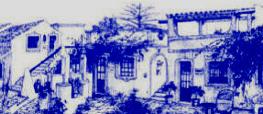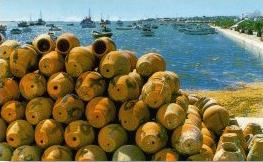|
Tavira |
| Portugal > Tourism > Algarve > Tavira > Handicrafts |
|
Municipality | History | Places of Interest | Beaches | Golf | City of Tavira | Lodging |
| A fair of handicrafts with lively work, artisans who in their houses and in little workshops insist in keeping alive the art, are some of the portraits that can still be seen today. The handicrafts are traditionally guided to a utility function, but in order to face the new needs of modern life, this activity directed its production to decorative items (used for example in tourist enterprises) or in miniatures as souvenirs that the tourists who visit the region look for. |
|
 |
| Reed baskets, wooden chairs and rope mats are made by the skilled hands of craftsmen in Tavira. They also produce cork boats, decorative objects made of shells, wrought iron work, lace articles and regional style blouses. But the most delicate handicraft products of Tavira are the flowers and designs cut out of paper, a very popular product of the region. |
| Empreita (a strip of Esparto) |
| One of the handicraft works which is most significant is certainly the esparto. It is particularly female work, very often made during the long Winter evenings. The palm, a kind of dwarf palm-tree, which in the woods, is cut in Spring (in May) nad is dried. After separating its fine stripes of leaves are wetted in water so to be worked. The woman knows how to entrance the fine palm leaves making stripes which will be sewn with "baracinah" (a string also made out of palm) so to give place to numberless items such as: large baskets, door-mates, baskets, hampers, hats... |
| Basket Work |
| The work of empreita allows a kind of basket - alcofa or balaio - manufacture but the basket has its prime material the cane. Whilst the empreita is particularly female work, the cane work is made almost exclusively by men. Its specially in the areas of the streams, where the cane grows, that this work as a greater meaning. We can still find artisans who make the eggs baskets, the fishing nets, fig drying mats. The wicker and the rush are other materials with a meaning in the manufacture of baskets. |
| Clay, Metal, Wood |
| The production is essentially shared for the home articles pitchers (which look the Romans amphora's), pots which keep the water fresh, the rough clay bowels; and articles for the construction like roof tiles, bricks, chimneys... The bucket of the bucket-conveyors were extensive apparatus to catch the octopus and are another "way out" for the clay. The blacksmiths, produce real artistic work in gates, protections for balconies, etc... The traditional carts pulled by the she-mules or horses, and which a few years ago were an integrating part of the social economical structure of the region, are made in wood. When there were no lorries, |
|
 |
| there were cart-men to transport goods: they were called "carreiros". Today, the carts, usually decorated with coloured paintings, are still used in the interior zones. In the coastal region, they can be seen very often, recovered for touristical strolls. Besides the colour of the carts, also the decoration of the animals which pull the cart is noteworthy. The saddlery and the trappings are still handmade. In Tavira and Cachopo some of the makers of saddles and saddlers still work. |
| Wool, Lace, Rags |
| If the local women do not devote themselves very much to the embroidery we can't say the same concerning the lace. With five needles (to make lace socks) or with knitting needle, the local woman performs varied pieces. Of particularly beauty is the bobbin lace. From a sketch on a cardboard placed on a bench with a cushion and on which pins are placed (which hold the knots which make the lace), the lace-makers manage skilfully the bobbins - little cylinders to hold the string. The noble work of the Algarvian ridge is the weaving. After the shearing, the wool is taken to the streams to be washed with ash-powder from oleander. After having been washed it is carded and spun by a spinning-wheel or by a spindle and finally it goes to the weaver's loom. To the Algarvian Northeast beautiful coloured band blankets are made. Saddlebags are also made, which today are adapted to bicycles and are used to transport books and foodstuffs. The advantage taken from the cloth which is cut in stripes to make tools which are sent to the weavers so to make the rag-blankets is common. All these activities portrait a cultural identity, a tradition which is necessary to preserve. |
|
Municipality | History | Places of Interest | Beaches | Golf | City of Tavira | Lodging |
| Portugal > Tourism > Algarve > Tavira > Handicrafts |
|
Handicrafts |